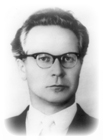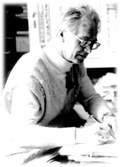
Background Information
The history of Doctor Buteyko and his method
Definitions of the method by its founder
____________
“Thirty seven years have passed since the time I found the cause of several of the most wide spread diseases which belong to so called “civilisation diseases“ (bronchial, cardiovascular, allergic etc.). These diseases have one common cause - alveolar hyperventilation or deep breathing. It had occurred to me: reduction in depth of breathing or normalisation of breathing may treat such diseases. An experimental study proved the validity of this presumption; more so, as it was based on the laws of physiology, biochemistry, biology and other disciplines.
...The essence of the method is to decrease the depth of breathing by will power and by relaxation of breathing muscles until one achieves a slight feeling of lack of air. All mentally healthy adults and children from the age of three can use the method.“
Dr. Konstantin Buteyko
(from the preface to the collection “Buteyko Method: the experience of the implementation in the medical practice“, Odessa, 1991)


The history of Doctor Konstantin Buteyko
____________
Humble origins studying “...the most complicated piece of machinery of all“ - the human organism.
Konstantin Pavlovich Buteyko was born on the 27th January 1923, into the small farming community of Ivanitsa (about 150km from Kiev). Inheriting his fathers enthusiasm for machines, Konstantin was enrolled into the Kiev Polytechnic Institute until his studies were interrupted by World War II when Buteyko joined his country's armed forces. After his experiences during the War, Buteyko felt compelled to study what he called “the most complicated piece of machinery of all“ - the human organism.

After long history of success, the Buteyko Method has stood the test of time
In 1958 - 1959 Buteyko conducted clinical studies on nearly 200 people, both healthy and sick. When the first data, various measurements, associations, deductions, correlations, regulations, etc., were obtained, all of these confirmed the correctness of Buteyko's discovery. On 11th January 1960, he presented his work to the Scientific Forum at the Institute of of Experimental Biology and Medicine at the Siberian Branch of the USSR Academy of Science and tried to explain the concepts of his thinking. He told those present of the experiments, which showed the objective linear relationship between the depth of breathing, the content of carbon dioxide in the body and vessel spasm and degrees of illness.
His research led him to conclude that many chronic health conditions, including asthma, allergies, and sleep apnea, were caused by a pattern of over-breathing that lowered carbon dioxide levels in the body. Despite initial resistance from the medical establishment, Buteyko's research gained recognition after successful clinical trials in 1968 and 1980. In both trials, the Buteyko Method was found to have a 100% success rate in treating patients with asthma and related conditions. The method has since gained popularity around the world and is used to treat a variety of breathing-related issues.

Trials in the land Down Under
____________
A timeless asthma treatment to take back control of your life
Unlike conventional asthma management, the Buteyko Method gives people a natural, drug free alternative to asthma management. The method is based on the laws of physiology and comprehensive scientific research. A starting point for this method is the presumption that asthma can be considered not as a disease, but as a defence mechanism of the body against hyperventilation (over breathing). The Buteyko Method has been proven to be more successful than other drug-free alternative approaches to asthma management. Its effectiveness was confirmed by a clinical trial in Brisbane in 1994 which was funded by the Australian Association of Asthma Foundations.
A method for everyone
Whilst the clinical trials tended to focus on treatment of Asthma, it should be understood that this method is also extremely effective for a whole range of related disorders such as allergies, rhinitis, bronchitis, sleeping disorders (such as sleep apnea).